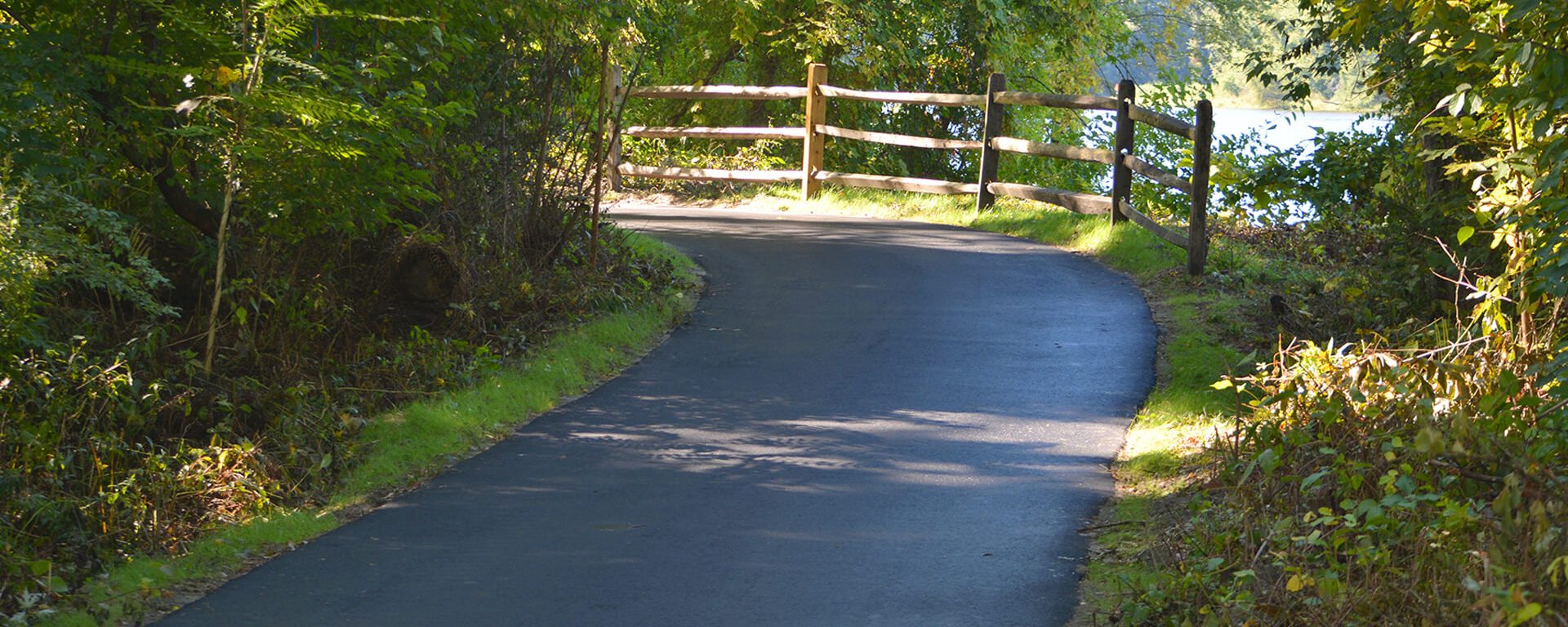East Hartford, CT — Goodwin University has taken another step closer to its goal of reuniting East Hartford and surrounding communities to the Connecticut River. With the recent completion of Phase IV of the University’s walking trail plan, the public can now travel southward more easily from Goodwin’s East Hartford campus. The new construction includes an additional 1,200 feet of paved, ADA-compliant trails from the end of the woodlands trail to the Wethersfield line.
“This trail system has been part of our strategic planning for a number of years,” said senior vice president Todd Andrews. “Several generations back, Route 2 and other obstacles cut off access to the River for local residents. Visitors to our trail system today are stunned when they see the power of the River first-hand, as well as the incredible woodlands and wetlands along the banks.”
The trail project began in 2014, with Phase I completed in 2016 and Phases II and III in 2018. The natural trail continues to the DOT trail coming down from the Putnam Bridge. With grant support of $150,000 already in place, when Phase V is complete, the paved trail will run all the way through Wethersfield to the Glastonbury line near the Putnam Bridge. The awarding of the DEEP grant for this final phase is currently proceeding.
Enjoying the beauty of the trail system is only one of the many positive outcomes of the project. “We believe that having access to the river, especially in ways that can be enjoyed in groups, really helps reduce social isolation,” offered Mark Scheinberg, president of the University. “Many people, particularly our local senior population, need contact, need to communicate. What better place to meet, talk, and explore than this?”
AARP has provided support for that philosophy of inclusion. In 2018, AARP awarded Goodwin a Livable Communities Grant of $2,500 to install educational trail markers describing the birds, insects, and other animals who call the riverfront home, and providing information on archaeological findings in the area. A second grant of $15,500 was awarded to Goodwin through the AARP Community Challenge to install four accessible picnic tables on a bituminous platform, providing East Hartford senior citizens with educational programs and trail walks. In 2021, AARP awarded Goodwin a Livable Communities grant of $5,00 to cover the cost of permanent exercise equipment installed at a central point on the trail near the picnic grove.
“AARP Connecticut was pleased to support this project,” said Nora Duncan, AARP Connecticut State Director. “People of all ages can benefit from physical activity and opportunities for social connection, and the riverfront is a beautiful natural setting. We hope that members of the community will be able to enjoy these trails and their amenities for years to come.”
The construction costs for the trail project were covered by grant support from the Department of Energy and Environmental Protection (DEEP) with matching funds from Goodwin. For Phase IV, which includes enhancing the accessible portion of the trail and overlooks leading to wonderful river views, the DEEP grant was $272,320 with $212,680 from the University. The general contractor was Capital Restoration and the primary consultant was Zuvic, Carr & Associates. Total costs for Phases I to V, including Phase V estimates, are projected at $1,767,134.
“CTDEEP’s CT Recreational Trails Grants have been supporting this project since 2014,” offered Kimberly Bradley of CT State Parks Trails & Greenways Program, DEEP. “The project satisfies all of our programs goals, including connecting urban areas with natural areas and providing ADA -compliant options. The Goodwin University trail provides an opportunity to break down physical barriers and connect our communities and to Connecticut’s natural resources.”
In total, 13,125 feet (8,100 natural trails and 5,025 paved trails) will constitute an environmental and historically significant jewel from the region.
“We are honored to be able to bring Connecticut residents and visitors closer to the River,” summarizes Scheinberg. “It’s a lesson in nature, a lesson in our history, and — most important — a way for people to get to know each other in a beautiful setting that’s accessible to everyone.”
Goodwin University is a nonprofit institution of higher education and is accredited by the New England Commission of Higher Education (NECHE), formerly known as the New England Association of Schools and Colleges (NEASC). Goodwin University was founded in 1999, with the goal of serving a diverse student population with career-focused degree programs that lead to strong employment outcomes.

